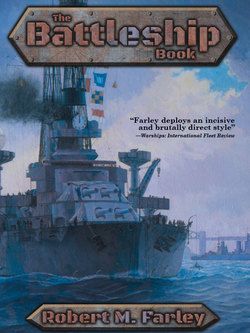Читать книгу The Battleship Book - Robert M. Farley - Страница 22
На сайте Литреса книга снята с продажи.
ОглавлениеEspaña
Laid Down: 1909
Launched: 1912
Completed: October, 1913
Displacement: 15,700 tons
Main Armament: eight 12” guns (four twin turrets)
Secondary Armament: twenty 4” guns (casemates)
Speed: 19.5 knots
Major Actions: None
Treaty: Pre-Washington Naval Treaty
Fate: Ran aground August 26, 1923
The battleship building fever that gripped the world in the wake of Mahan’s Influence of Sea Power Upon History extended to small navies as well as large. Of course, smaller navies operated under much more severe constraints in terms of construction and maintenance costs. Spain, having lost much of its naval strength and virtually all of its overseas empire in the Spanish-American War, concluded that dreadnoughts were necessary for national defense. After several abortive efforts, it ordered three ships of the España class, which would become the smallest dreadnoughts ever constructed.
Jaime I, sister of España
The British firm Vickers participated in the design process, but all three ships of the class were eventually built in Spanish yards. This was somewhat unusual for a navy as small as the Spanish, as most similarly situated powers simply placed orders at foreign yards. However, had Spain done this, the ships might have been seized by the Royal Navy at the beginning of World War I, as happened to Turkish and Chilean ships under construction in British yards. As it was, wartime material shortages delayed the completion of the final ship for eight years.
España was small, but her heavy armament made her more than equal to any pre-dreadnought battleship. Small and short of range, the Españas were not well-suited to any mission other than coastal defense, which occupied most of their service time. The three ships also engaged in shore bombardment of rebel positions in Morocco. Unfortunately, this mission proved hazardous. España hit a rock on August 26, 1923, and broke apart in an ensuing storm. Strangely, this accident happened exactly one year after the French battleship France had hit an uncharted rock and sank.
Seven years later, following the deposition of King Alfonso XIII, the sister ship Alfonso XIII was renamed España. The Armada Espanola floated various schemes for refit and modernization, including one ambitious plan for reconstructing España and her surviving sister along the lines of the German pocket battleships. However, these plans proved too expensive, and both ships were laid up until the beginning of the Spanish Civil War.
Espana, ex-Alfonso XIII
España lay in the territory claimed by Francisco Franco, and Nationalist forces quickly refurbished and returned her to service. While carrying out blockade operations, she hit a Nationalist mine and sank (all but five of her crew were saved). The third sister, Jaime I, had similar luck. Under Republican control, she suffered an internal explosion and sank in June, 1937.
After the end of World War I Spain considered, but rejected, a larger naval program. Expense was probably the largest reason, although the “naval holiday” declared by the Washington Naval Treaty undoubtedly played a part. The designs under study by the Spanish Navy would, if constructed, have been some of the largest battleships and battlecruisers in the world at the time. The existence of such ships would have made Spain’s situation in World War II more complex, as they might have provided enough of a threat to British naval power to justify a preventative attack of the sort that the Royal Navy launched against the French fleet at Mers El Kebir.
Author’s Note
The Spanish chose a very different route to naval sufficiency than the Southern Cone navies. Instead of buying advanced, large battleships, they concentrated on smaller, more manageable vessels. Unfortunately, they didn’t fare much better than their Latin American brethren. The Españas are interesting chiefly for what they accomplished on an extremely small hull. They demonstrated that the dreadnought form could achieve a considerably more lethal unit than the pre-dreadnought, even on roughly the same displacement.
Related Entries:
Inspired by… HMS Dreadnought
Contemporary of… USS Michigan
